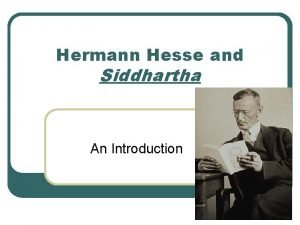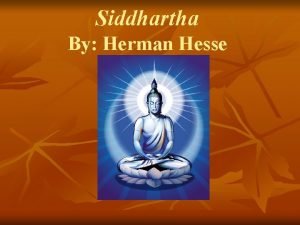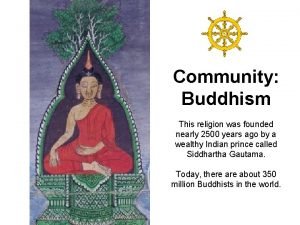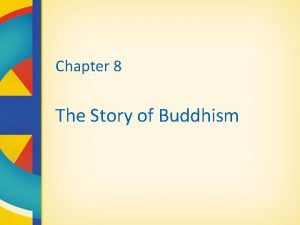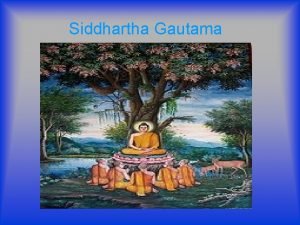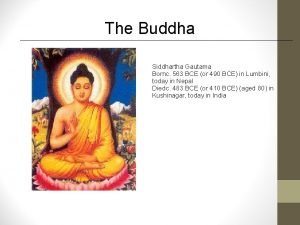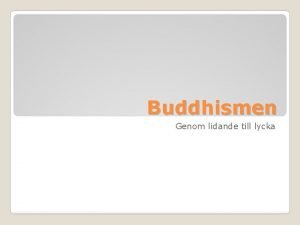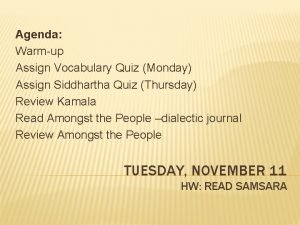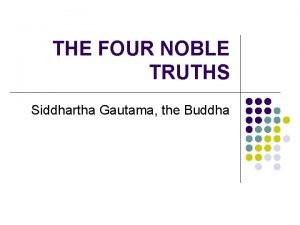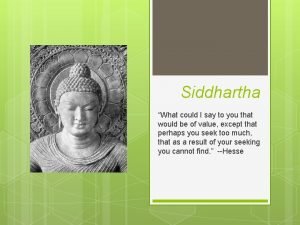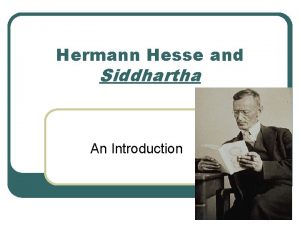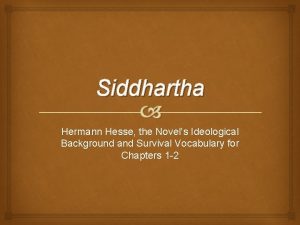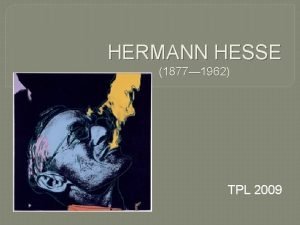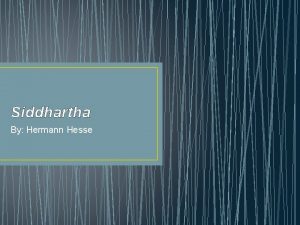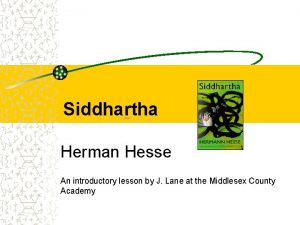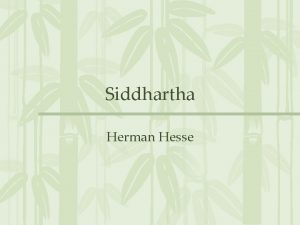Hermann Hesse and Siddhartha An Introduction Hermann Hesse

















- Slides: 17

Hermann Hesse and Siddhartha An Introduction

Hermann Hesse (1877 -1962) German painter, poet, and novelist l Depicted in his works • the duality of spirit and nature • body versus mind • the individual's spiritual search outside the restrictions of the society l

Hermann Hesse Born on July 2, 1877, into a family of missionaries and religious publishers in the Black Forest town of Calw, in the German state of Württemberg. l Expectations from family l Entered Seminary in 1891; expelled in 1892 l

Hermann Hesse Worked in book stores as young man l Published first work in 1899 l Visited India in 1911 and became interested in studies of Eastern religions l Joined pacifists in anti-war activities during World War I l

Hermann Hesse During World War II Hesse opened his home to intellectual emigrants who had to flee Nazi Germany l Awarded the Nobel Prize for Literature in 1946 (for his novel The Glass Bead Game) l After receiving the Nobel Prize, wrote no major works l

Hermann Hesse l l l Died August 9, 1962 at the age of eightyfive At the time of his death, Hesse, in addition to his countless novels and collections of poems, had written 3, 000 literary reviews and 35, 000 personal letters. He had painted about 3, 500 watercolors. He is still one of the best-selling German writers throughout the world.

1922 - Siddhartha l Hesse's ninth novel l Written in German, in a simple yet powerful, lyrical style l Wasn’t published in the U. S. until 1951 and became influential during the 1960 s




Hesse and the Hippies Following his death in 1962, Hesse’s novels revived popularity due to association with popular themes of the counterculture (or “hippie”) movement l Hesse became a “cult hero” to 1960 s youth l Many fans of his literature were going through personal journeys in identity l

Siddhartha l An allegorical novel that deals with the spiritual journey of a boy known as Siddhartha l The protagonist spends his lifetime searching for peace, faith, and meaning

Siddhartha l l l Story takes place in ancient India around the time of Gautama Buddha Likely between the fifth and seventh centuries BC. The Buddha's name, before his renunciation, was Prince Siddhartha Gautama. In Siddhartha, the Buddha is referred to as "Gotama"

Siddhartha The word Siddhartha is made up of two words in the Sanskrit language, siddha (achieved) + artha (meaning or wealth). The two words together mean "he who has found meaning (of existence)" or "he who has attained his goals".

l l A major preoccupation of Hesse in writing Siddhartha was to cure his “sickness with life” by immersing himself in Eastern philosophy In order to complete the novel, Hesse lived as a semi-recluse and became totally immersed in the sacred teachings of both Hindu and Buddhist scriptures

Structure of Siddhartha l l The novel is structured on the three stages of life of traditional Indian philosophy: student (brahmacarin), householder (grihastha) and recluse/renunciate (vanaprastha) AND on the Buddha's four noble truths (Part One) and eight-fold path (Part Two) which form twelve chapters, the number in the novel.

Why are we reading Siddhartha? l l The study of Siddhartha provides not only insight into Eastern religious thought but also a valuable representation of the influence of religion and culture on literature Provides insight into theme of one’s search for personal identity
 Siddhartha theme
Siddhartha theme Hesse
Hesse Nebelgedicht
Nebelgedicht Hermann hesse knulp
Hermann hesse knulp Siddhartha chapter 3 summary
Siddhartha chapter 3 summary Siddhartha setting
Siddhartha setting Who was siddhartha
Who was siddhartha Siddhartha chapter 8
Siddhartha chapter 8 Number of buddhism followers
Number of buddhism followers Leanora sutter
Leanora sutter Siddhartha was born into the
Siddhartha was born into the La famille de siddhartha gautama
La famille de siddhartha gautama David siddhartha patel
David siddhartha patel Bornc
Bornc Siddhartha
Siddhartha Siddhartha vocabulary
Siddhartha vocabulary Four noble truths siddhartha
Four noble truths siddhartha Siddhartha characters
Siddhartha characters

